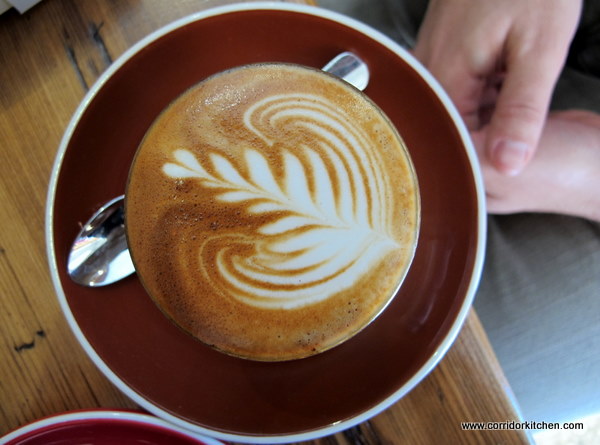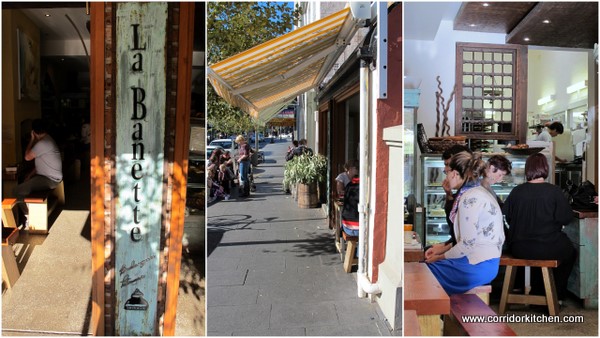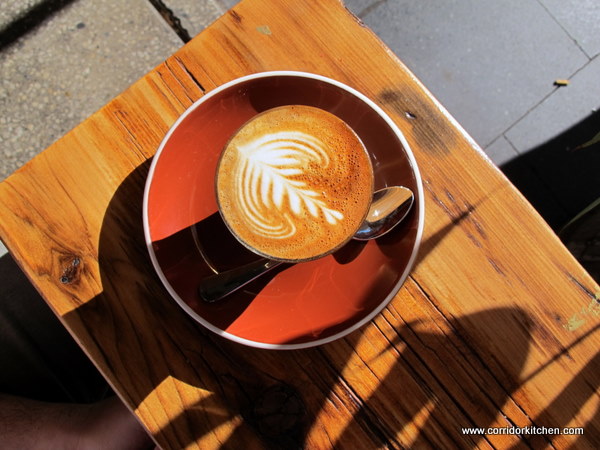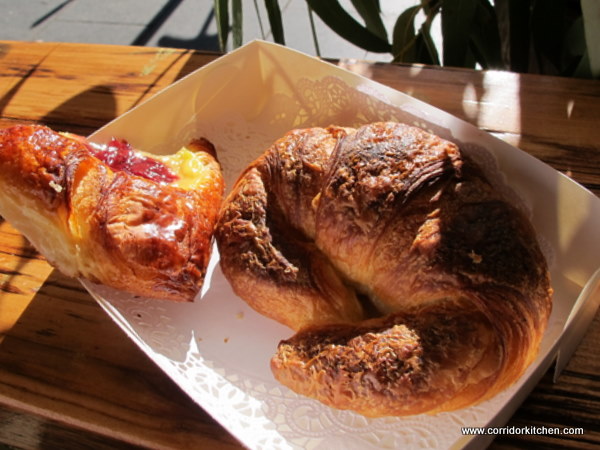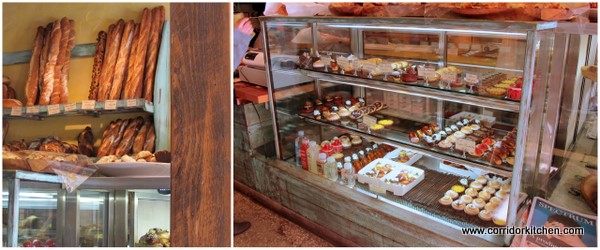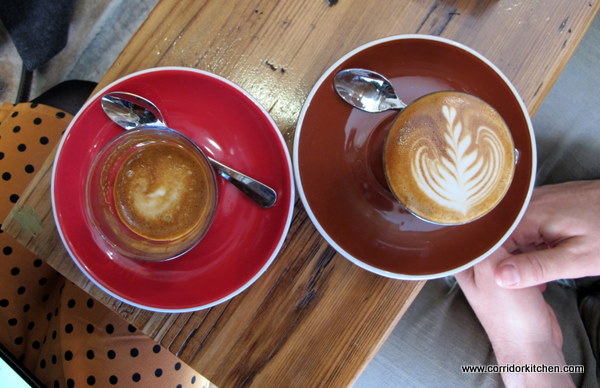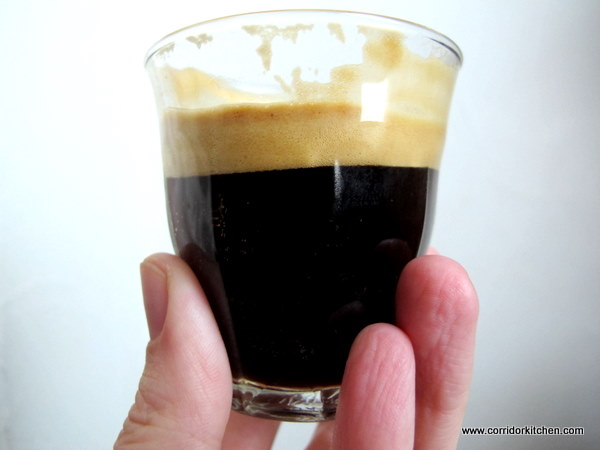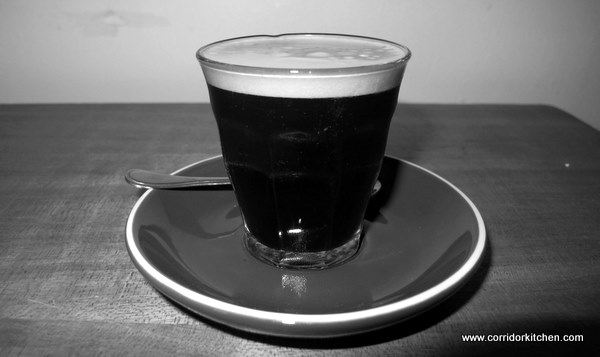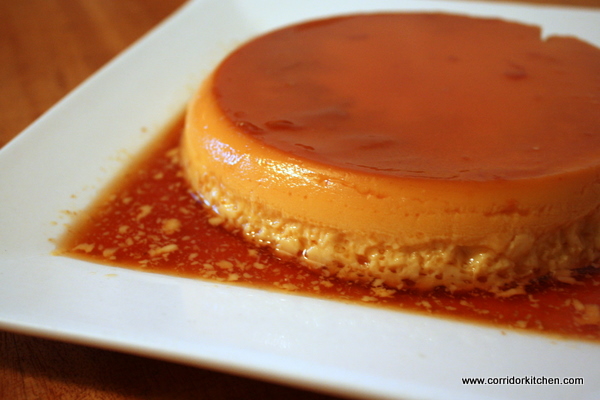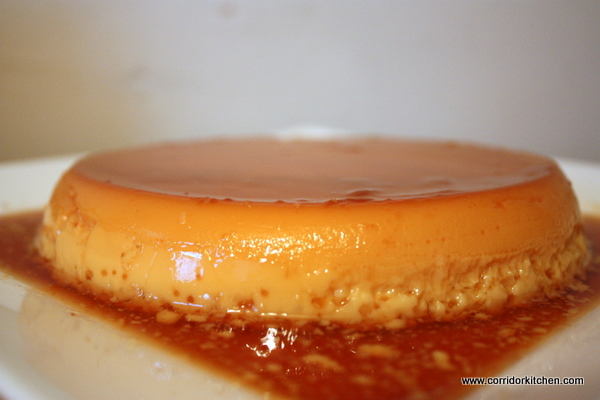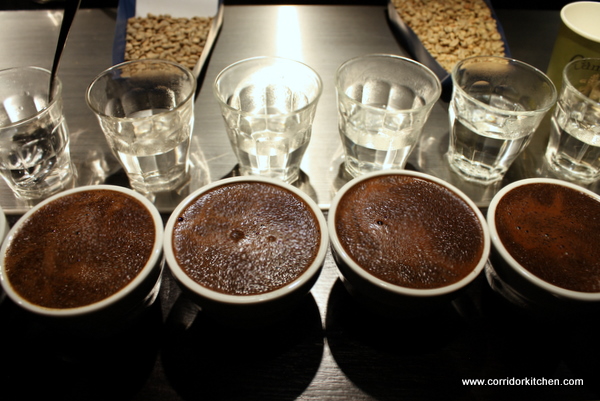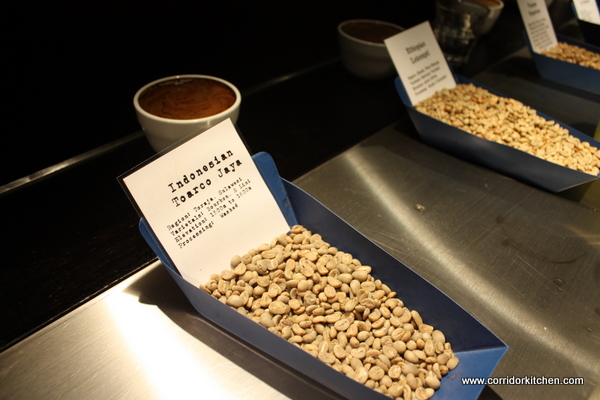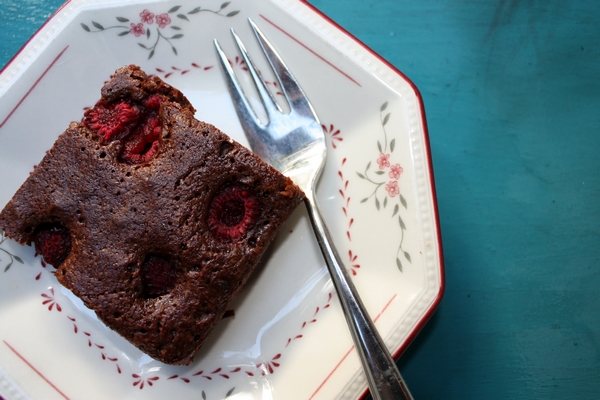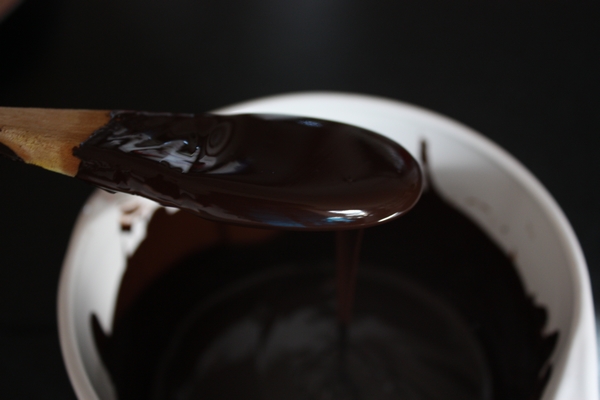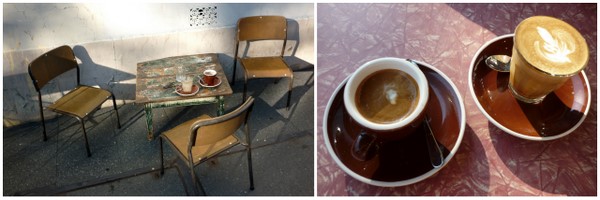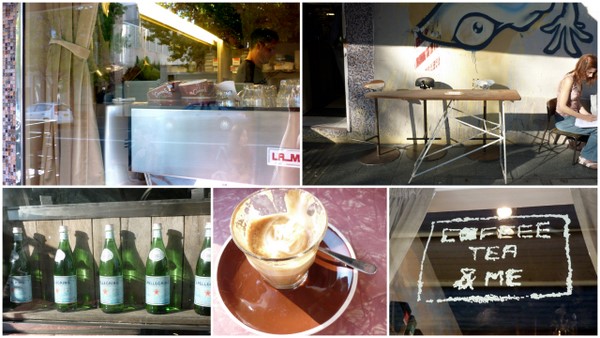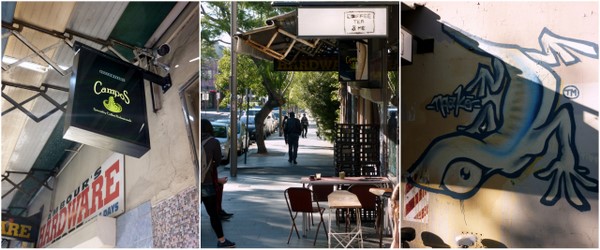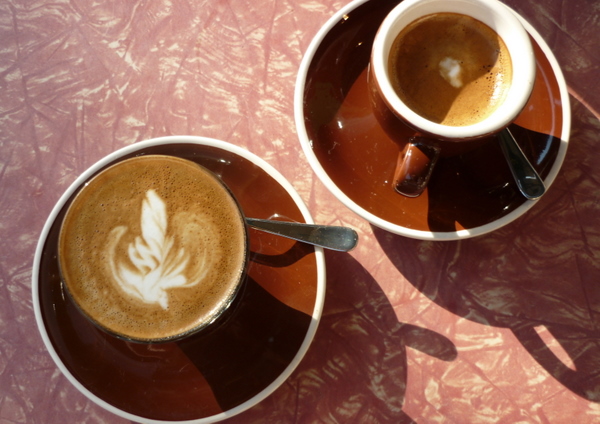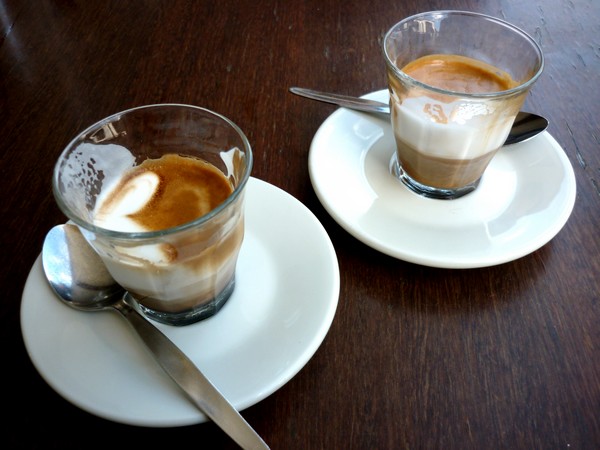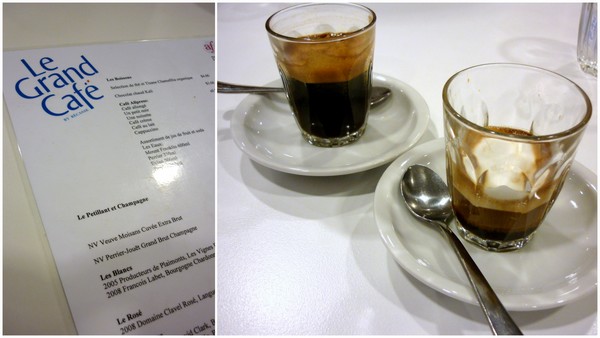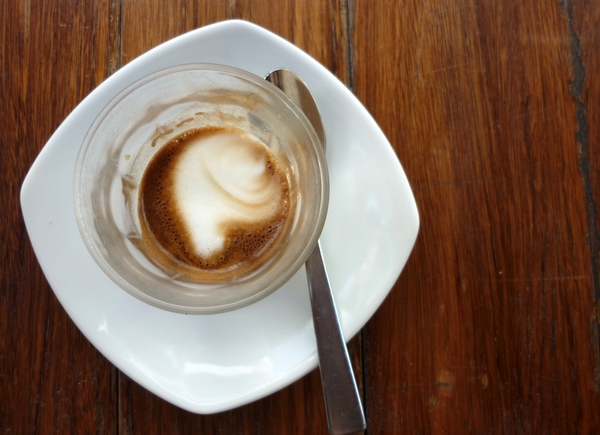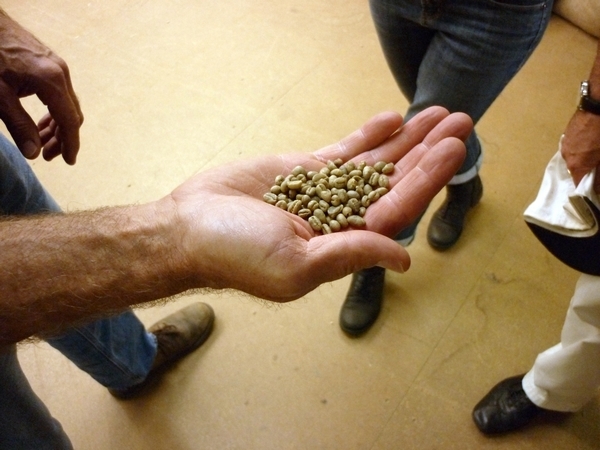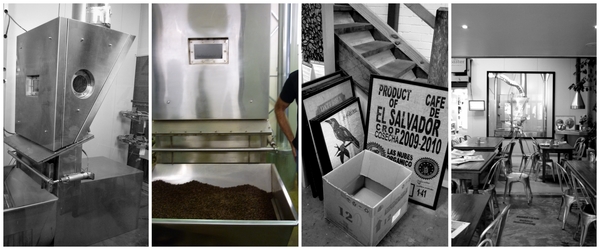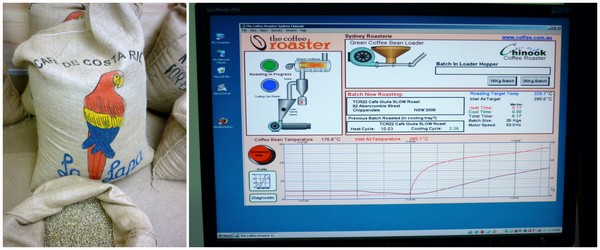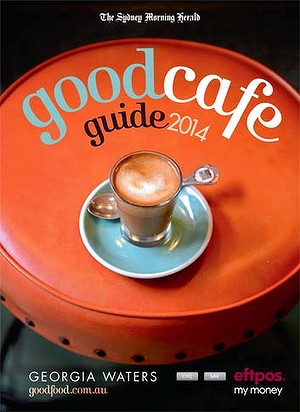You may not know this about me, but I’m a sucker for a striped awning. Anyone clever enough to attach one to the outside of their cake shop/patisserie/boulangerie/espresso bar (because that’s where you always seem to find them) has a good chance of piquing my interest. And if it’s a sunny Saturday morning and I’ve ‘forgotten’ to have breakfast before Senhor R and I go out for coffee, your chances increase exponentially.
Thus ‘La Banette’ has always been referred to by me as ‘the place in Glebe with the yellow striped awning’. I don’t spend much time in Glebe because I find the coffee to be as it is in Newtown – a few brilliant places dotted here and there, but you gotta know where to look. And while in Newtown I have a fairly good idea (Campos, Vargabar Espresso, The Old Fish Cafe, Berkelouw Books), in Glebe I have no clue. And I’m usually too damned lazy to find out.
So I never realised it was a patisserie, boulangerie and café, let alone the second in a series (the other is in Avalon). After visiting, a quick Google reveals that the owners, Vince Luong and Uyen Le, have garnered acclaim all over for their interpretations of French classics. And it’s no surprise.
The interior is small but artfully arranged with bench seats and tables down one side and pastries, cakes and breads wherever they will fit. The selection is impressive and, to my mind, not at all on the expensive side. On our first visit we pick up a rustic sourdough baguette for something like $3 and grab our standard coffees to have in. The baguette isn’t as sourdough-y as I like it, but it have terrific crunch factor. The coffee is good. Very good. Good, rich crema, latte art which I can take or leave in real life but can’t get enough of for blogging. On our next visit we order croissant and a danish and they are divine; so buttery, rich and flaky I could eat ten.
The procedure is to order and pay at the counter before you sit down and the staff will bring your order out to you, or you can get it to go. They purport to be a bakery, not a cafe and thus although all the coffee comes with real saucers, cups and spoons the food comes in bags, boxes and on doilies. They request that you dispose of them yourself (they have bins) and I take no issue with this but if I have one criticism it’s that this policy seems wasteful. However, in the face of some of the best pastries I’ve had in my life and golden delicious coffee, this seems a small thing.
So, what less-than-subtle sign is guaranteed to pique you interest in a place?
La Banette
18 Glebe Point Road, Glebe 2037
(02) 8095 9688
7:00am – 6:00pm Monday – Friday
A while ago while visiting Don Campos in Alexandria, I noticed a sparkling long black on their menu. I’d always wondered what it was and how it was made, but of course I didn’t do anything as obvious as to ask what it was or better yet, order it. It remained an elusive espresso mystery.
I’d pretty much forgotten about it until I visited the Cupping Room a couple of weeks ago. I asked Todd who was hosting the session what it is and he said it basically a frozen latte glass containing a ristretto topped up with iced mineral water. It’s a cooling summer coffee for those of us who aren’t so fussed on the creamy, milky or sweet iced coffees you usually come across.
I know it’s not warm here right now but it must be somewhere so I decided I’d post it again before I forget. Todd recommended a piccolo/short black glass rather than a latte glass so that’s what I used.
The flavour was mild and refreshing and actually, it makes a lot of sense when you think about it when I think back to the terrible espressos I had in Argentina and how they always came with a tiny glass of mineral water to soften the blow. The sparkling long black is no longer on Campos’ official menu so ordering it is likely to elicit some raised barista brows…
embedded by Embedded Video
Sparkling Long Black
An espresso machine
A frozen cup/glass
Freshly ground coffee
Sparkling mineral water, chilled
Run a shot of about 15 ml of espresso into the cup or glass. Top with chilled mineral water. Serve.
So, is there a drink you’ve been dying to try?
In my household, I do most of the cooking, because I’m speedy, pragmatic, and an absolute control freak. Everything I make is geared towards minimum effort for maximum results. As such I don’t prepare many of what I perceive to be ‘high risk’ foods.
So on Sunday when my boyfriend, Senhor R, offered to whip up a Pudim Flan (Crème Caramel) this week, I was all for it, even though neither of us have ever attempted to make such a thing. It turned out to be remarkably simple, which is in no way a reflection on his culinary skills. And it was so delicious that he actually made another one on Wednesday! I could get used to this…
Growing up, every Portuguese restaurant I ever went to had three staple deserts; Mousse Chocolate, Arroz Doce (Sweet Rice) and Pudim Flan (Crème Caramel), to be washed down with as many ‘bicas’ (espressos) as possible. Although there were occasional surprises such as Baba de Camelo (camel’s dribble) or the potentially explosive Molotov Pudding, you could always find these three.
My Mum had the monopoly on the Mousse Chocolate market and was not averse to making her own custard for other desserts, but she never attempted a Pudim Flan. It remained an elusive delicacy that other peoples’ mums brought to feast-like gatherings, or something made in restaurants by people who understood such things.
The closest we ever got to Pudim Flan was a packet of this dried stuff sitting in our pantry for many years. It’s possibly still hiding there somewhere. I have a dim memory of a packet being attempted once, but clearly with poor results as it was never spoken of again.
Then in Argentina Lau discovered her love for flan, mostly through her delight of dulce de leche which is always offered with it. The Flan was an excellent excuse to eat the giant dollop of dulce, much in the way few people actually add more than a token amount of milk to their Milo to legitimise the ‘drink’ status of it.
Last weekend as I was idly flipping through a Portuguese cookbook, and I came across this recipe and, armed with an abundance of fresh eggs I went to work. The question was – would Lau like it without the dulce de leche?
Pudim Flan from The Taste of Portugal by Edite Vieira
Caramel
110g sugar
3 Tablespoons of water
Custard
4 eggs
90g sugar
450ml milk
Preheat the oven to 180° C.
Pour the 100g sugar into the pan with the water and rapidly heat until all the mixture has ‘foamed’ and becomes a golden liquid caramel. Pour the caramel into the bottom of a round dish- I used a 7 cup pyrex storage dish. Turn the dish quickly to spread the caramel around the base. It doesn’t matter if it’s uneven, it will melt later.
In a saucepan, bring the milk up to body temperature. Whisk in the eggs and the 90g of sugar until well mixed. Pour into the dish.
Place the dish in a bain marie – basically a much larger oven proof dish with boiling water coming halfway up the side of the flan. Bake for 45 minutes to an hour. If it starts to brown too much, cover it with foil.
When you remove the flan from the oven, it will still be a bit jiggly – it will cool as it sets. When it is almost completely cool, run a knife around its edge, put a plate on top and turn it upside down. Serves 6.
Do you have a dessert you’ve never been game to prepare?
While it might be a common occurrence for other food bloggers, it’s not usual for me to receive invitations to, well, anything. So when the folks at Campos asked me if I’d like to come check out The Cupping Room above their flagship store in Newtown, it’d be an understatement to say I was excited, especially since it had been on my to-do list since forever.
When I arrive at 5 to 3 on a Saturday, it’s hot and crowded and I can’t move for the customers. I’m not surprised, it’s one of the reasons I don’t come here that often, but when my partner in crime arrives, she’s shocked. ‘It’s as if there aren’t any other coffee shops in Newtown,’ she marvels. Well, for some, that may be true. We elect to wait outside. 10 or so minutes later we’re led through the crowd to the back of the store, up the steep stairs lit by a single dangling light bulb. Like an old-time speakeasy, a panel in the door slides open and a pair of eyes peer out. ‘Two?’ Asks a voice. We nod. We enter.
The space is pitch black save for a long wooden table, stainless-steel edged and lit by a line of spotlights. Our host, Todd has laid out 6 small bowls of coarsely ground coffee for each of us to ‘cup’ or taste. Cupping, he explains, is standard practice for roasters all over the world. The idea of cupping is that because you’re removing all the variables inherent in brewing coffee, you’re leveling the playing field and you really are just tasting the coffee. Each step of the cupping is usually given a score and that’s how a coffee is chosen by buyers.
Latte glasses of water and metal spoon glint in the light as Todd explains the process. The first step, he says, is smelling each grind. We inhale each cup (well, not literally, but you know what I mean) and leave the descriptions to the expert. Next, Todd lets the coffee steep in 93° water for 7 to 15 minutes. We then break the ‘crust’ of grounds that has formed on the top, careful to expose rather than destroy the crema. Once we’ve ‘crusted’ each cup we are to taste each one in turn without speaking – this is the time to form our initial impression. Each coffee must be taken with a single, sharp sip from our spoon. Todd makes a loud definitive ‘slurp’ with his, practically inhaling the brew but we’re more timid.
Afterwards we take our time though the 6 grinds, which have been set up in a very deliberate order, and we discuss the flavour profiles of each one. Todd says there’s no wrong answer here and encourages us to describe the coffees. I find this very difficult to do, but as soon as he mentions a flavour, for example ‘citrus’ or ‘earthy’, I find his description fits what I’m tasting, and it’s more than just the power of suggestion.
The coffees we taste are:
Indonesian Toarco Jaya – a solid, well rounded base.
The Ethiopian Lekempti – fruity, lemony. Yum!
Panama Emporium – I’m not sure how to explain this, but I don’t like it. It reminds me of that nauseous feeling of having had 5 or 6 coffees.
Colombian el tiestro –I liked it but I don’t remember much else about it.
Kenya Gethumbbwini – Very strong and zesty, like lemon peel.
Supermarket coffee – tastes like nothing.
Campos cups a variety of beans every day in their warehouse to maintain the consistency of their signature blend, ‘Superior’. They will roast on a Monday, cup in a Tuesday and adjust the ratios accordingly on a Wednesday, and this cycle continues each day. Visiting coffee plantations and tasting their crops has been recreated in a much more pristine and theatrical setting here at the cupping room. I ask what coffee producers would think of their gleaming setup and he admits they’d probably find it pretty bizarre.
The Cupping Room
193 Missenden Road,
Newtown NSW 2042
(02) 9690 0294
Sessions Tuesday to Friday at 7:30 and 2.00pm
Saturday’s at 8:30am, 1:00pm and 3:00pm
As the weather cools down, the rain pounds on the roof and my kitchen floods at regular intervals, it feels like the time to indulge in a slice of something sweet with a cup of something hot, the eternal combination of comfort seekers everywhere.
These brownies are ideal for weathering the storm – quick, easy and you don’t even have to have chocolate on hand to make them. They’d be perfect with a cup of tea if tea interested me in the least, but I prefer them with a coffee or a big glass of cold milk. That way I can either be an incredibly grown up or a 6 year old child, whichever seems easiest at the time.
Cocoa Raspberry Brownies (Adapted from The Stone Soup)
150g butter
1¼ cups 255g caster sugar
¾ cup (80g) cocoa powder
1 teaspoon vanilla extract
2 eggs
½ cup (75g) plain flour
1 cup frozen raspberries or morello cherries
Preheat oven to 150°C. Line a slice tin with two sheets of baking paper so that it overlaps the sides.
Melt butter in a medium saucepan. When just melted, remove from the heat and stir in the sugar and cocoa powder, ensuring there are no lumps.
Add the vanilla extract and eggs and mix well. Gently stir in the flour until just combined, being careful not to over mix. Pour the mixture into the lines pan. Dot the brownies with frozen raspberries.
Bake for 45 minutes or until the top feels just set. Cool in the tin, cut and then serve.
What’s your favourite wet weather recipe?
Killing two, three or possibly even 10 birds with one stone has always been my bag. Thus I’m always on the lookout for good coffee and, simultaneously, good cafés to feature on Corridor Kitchen. So when I noticed a partially constructed hole-in-the-wall coffee bar on Redfern Street about a month ago, I have to admit I started stalking it.
I was looking up City of Sydney planning applications that very day to try and figure out when they’d get permission for outdoor furniture – I figured that’s when they’d open. I walked past most days ‘just to check it out.’ Soon a tantalisingly nonspecific ‘coming soon’ sign materialised. I checked out other cafés, but I wasn’t interested in any other cafés. I wanted to check out Coffee tea & me.
Then one morning I walked by and miraculously, it had opened. And, true to form, I didn’t have my camera on me. Blast! I grabbed a coffee anyway and it was pretty damn good. Campos, which contrary to popular opinion is not the best coffee in the whole of Australia but does ensure a level of barista training and screening that few brands adhere to.
I returned a couple of days later. The place looked like a hipster paradise with only enough floor space for coffee and sandwiches. As the Redfern Street area continues to gentrify with the likes of Baffi and Mo, Eathouse and Pitt St Diner, it’s hardly a surprising location for a teeny-tiny espresso bar.
Coffee tea & me is literally on a bus stop and next to a hardware store. It’s easy to spot its scattering of battered vintage school chairs, bicycle seat bar stools and laminate tables to perch on. I was there around 8am and not surprisingly most orders were takeaways. It’ll be interesting to see what the vibe is like on weekends.
The coffee was good, syrupy and golden as I’ve come to expect for Campos. The two guys working there were friendly as a clump of eager takeaway customers awaited their coffees. Overall I was impressed and will definitely return.
Coffee tea & me
93b Redfern Street,
Redfern NSW 2016
(02) 90087121
Monday-Sunday, 6:00am – 6:00pm
Can you believe it? Corridor Kitchen is 6 months old! It seems like a small thing, but I feel like celebrating.

Image courtesy of Omer Wazir
To celebrate, I have one copy of the Australian Women’s Weekly cookbook Kids’ Birthday Cakes to give away. To enter, just comment and let me know your favourite childhood birthday cake. Entries close midnight, Monday May 2nd and the winner will be announced the following Friday. Good luck! Please note: the book can only be shipped to the following countries.
So by now you probably know the macchiato is my current coffee of choice. I love an espresso or a ristretto, but a few too many black-coffee-on-an-empty-stomach days on a Portuguese holiday kinda cured me of the habit, as did my frugal nature; $3 or more for a shot of coffee with no additions just seems like bad value. A macchiato is also a bet-hedging drink; the milk tempers a short black which may or may not be brilliant, hiding any extra bitterness it may have. Here’s a list of 3 places I think make a great one (in no particular order).
1. Plunge Coffee, Summer Hill
This had been on my wishlist for ages and I wasn’t disappointed. Sitting on a street that real estate agents would describe as ‘funky’ and local council marketing would describe as ‘a village’, it’s a nice place to sit and there’s plenty of seating. The coffees here are beautiful and taste as good as they look. A bit steep at $3.50 but the milk is silky smooth and so is the flavour. They use coffee alchemy coffee.
Plunge Cafe
48 Lackey Street,
Summer Hill NSW 2130
(02)9799 9666
www.plungecafe.com.au
2. Le Grand Café, Clarence Street
The café in the foyer of Alliance Française sells scrummy looking pastries by Bécasse and does more substantial food as well, but I’m more interested in their coffee. All coffees are $3, unless you prepay and buy a bunch at a time and then the work out at $2.50 each. They use Allpress coffee which I like and their macs are not too long with a generous daub of froth. The service is good too.
Le Grand Café
257 Clarence Street,
Sydney CBD NSW 2000
(02) 9267 1755
http://www.afsydney.com.au/Cafe/Default.aspx
3. Single Origin Roasters, Surry Hills
This macchiato is so ridiculously expensive I considered not recommending Single Origin on that basis. It is also hipster paradise and only open on weekdays. That said for $4 you’ll feel no qualms about returning it if it’s not to your liking. I’ve been there quite a few times and have never had to. You also get a choice of beans if you so desire. The branding of this place is such that 250g bags are sold at 15 bucks a pop. Not so rapt on the tiny stools and tables either.
Single Origin Roasters
64 Reservoir Street,
Surry Hills NSW 2010
(02) 9211 0665
www.singleorigin.com.au
It’s funny, but when I’m pressed for time I suddenly am able to achieve a whole lot more. Take this morning, for example. It was my first day at a new job and I suddenly found time to bake a bunch of pumpkin scones. Less time = more baked goods in my household, although it may also have something to do with the fact that I needed a recipe to post today…
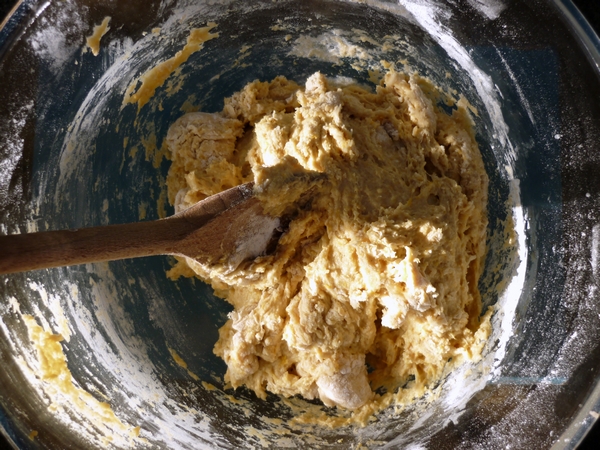
No matter, these scones are a breeze. I knocked it up in half an hour and it was well worth the effort. Although not as light and fluffy as the lemonade scones I made a while back, they are the kind of thing you can eat plain, although I think you could up the mixed spice and pumpkin.
Pumpkin Scones from ABC Queensland
50g butter at room temperature
¼ cup brown sugar
1 egg
½ teaspoon mixed spice
1 cup cold mashed pumpkin (otherwise the butter will melt)
2½ cups self-raising flour
Milk or egg, for glazing
Butter and honey, to serve
Preheat oven to very hot, 220°C. Line baking tray with paper.
Cream butter, sugar, eggs and spice. Stir in pumpkin with a wooden spoon.
Add flour in 3 batches, stirring with spoon. The dough will be quite sticky and elastic.
Place dough on a lightly floured bench and split in half. Continue halving the dough until you have 16 even portions (I got 15, one was a bit of a runt so I broke it up and added it to the other smaller ones). You may need to heavily flour your hands to do this. Quickly form the portions into balls.
Place the scones in the centre of the tray, so they are just touching. Bake for about 12-15 minutes, or until golden and cooked through. Slather with butter and honey and serve immediately, don’t wait!
What about you? Do you find you get more done under pressure?
I have my Mum’s family to thank for my love of coffee. When I was a little kid, I loved eating a spoonful of froth off my mum’s once-a-week cappuccino after the grocery shopping. Then later, one by one, everyone bought espresso machines. When I was 16 I started drinking coffee in earnest, careful not to overdo it. Never more than one a fortnight, I vowed. Then I got my first job of any consequence at a coffee shop and became fascinated with the process of coffee making. How could I get my cappuccinos as good as Milan, my Serbian boss? That was it; I was hooked on coffee. And now I’m traipsing all over, looking for the best coffee I can find.
So when my aunt suggested the coffee roaster for a family get-together, I was more than happy to oblige. And when the owner Dan Fitzsimmons (a friend of my aunt’s) offered us a tour of the roasterie, I was excited. Another step in the coffee-making process revealed.
The Coffee Roaster was one of the first of its kind in Sydney, pretty obvious when you see their web address, www.coffee.com.au (don’t worry; the website is going to be updated soon). We go upstairs where the unroasted beans are stored and poured into the roaster. Dan starts by explaining how the coffee is stored in hessian sacks but says that there’s an increasing trend towards plastic liners and that it’s important to get as much of the dust and dirt out of the coffee as possible prior to roasting.
The coffee roaster uses a computer-run Chinook air flow coffee roaster which basically means the beans are roasted on a cushion of air. The system is computerised, and each roast is saved as a file which has been optimised in terms of a variety of variables (temperature, length of roast etc.) for the individual blend or even the individual coffee shop they are supplying. He contrasts this with other roasters who roast each batch more by sight, saying that he prefers about his method as once each coffee profile has been established it makes no difference who is in charge of the roast, they will just download the correct file and thus the result will be consistent.
Dan pours some beans into the roaster and selects a profile, the TCR22 for Café Giulia in Chippendale, a long, slow roast. Dan explains that this will cut out the acid or caramel notes and lead to a darker finish where a faster, hotter roast would leave you with a lighter, more caramel finish.
We move downstairs to watch the roasting process, and Dan contrasts The Coffee Roaster’s method with that often employed by roasters. Usually they’ll have around 6 blends roasted 6 different ways, and will have one person roast, store and top-up as needed while another person fills orders with them. He, on the other hand is storing the unroasted beans until orders are placed. Customers like café Giulia call up the day before they need a fresh supply and Dan and the team will roast the batch the next morning and deliver it immediately. The whole process is surprisingly quick; they can roast about 4 batches an hour. As the coffee cools he shows us the dust removed via the roasting process – a whole bin full!
On storing coffee – a hotly contested topic in barista/roaster circles – Dan says that they package their beans as soon as they have cooled in a bag which lets excess gas out but does not let oxygen in. Every time you open it you are letting in microbes and yeasts which feed on the coffee and quicken its expiry, so he recommends storing coffee in a vacuum seal container where you can suck all the air out, or in the same kind of bags they use, so you can squeeze it out. Keep your coffee out of the light and don’t worry about putting it in the fridge or freezer – you will just be refrigerating/freezing stale air. And his number one storage tip? Use your coffee up as fast as possible because as soon as it’s roasted it begins to deteriorate.
What obsessions run in your family?
The Coffee Roaster
380 Botany Road,
Alexandria NSW 2015
1800 806 200
www.coffee.com.au
About me
 Sharing easy recipes, hunting down the best coffee. Honest accounts, nothing too serious. Read more...
Sharing easy recipes, hunting down the best coffee. Honest accounts, nothing too serious. Read more...Recent Posts
- Aerpress means no more shit #travelcoffee and #workcoffee
- Why I write and four ace bloggers who do it better
- The five best things I ate in London
- Shoreditch is awesome, airports are not
- I quit sugar? Do I bollocks.
- Cubao Street Food, Alexandria
- The Reformatory Caffeine Lab, Surry Hills
- Brewtown Newtown
- Stay caffeinated over Christmas
- Gumption by Coffee Alchemy, Sydney CBD
Popular posts this month…
 Sparkling Long Black posted on May 10, 2011
Sparkling Long Black posted on May 10, 2011  Review – Philips Saeco Intelia posted on January 10, 2012
Review – Philips Saeco Intelia posted on January 10, 2012 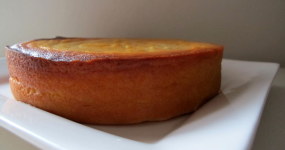 Kosher Whole Orange Cake posted on July 5, 2011
Kosher Whole Orange Cake posted on July 5, 2011  Cheat’s Dulce de Leche posted on January 7, 2011
Cheat’s Dulce de Leche posted on January 7, 2011 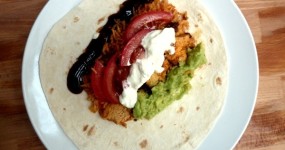 The quest for Mex part 2 – Feisty Chicken Burritos posted on December 21, 2010
The quest for Mex part 2 – Feisty Chicken Burritos posted on December 21, 2010  Salat Hatzilim posted on January 28, 2011
Salat Hatzilim posted on January 28, 2011 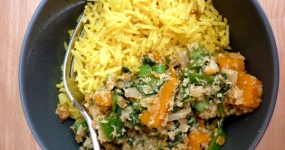 Sri Lankan Spinach with Coconut posted on December 10, 2010
Sri Lankan Spinach with Coconut posted on December 10, 2010 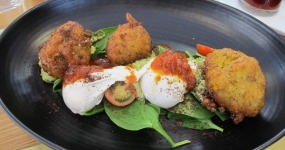 Lau’s Ultimate Corn Fritters and the four fritter truths posted on March 1, 2013
Lau’s Ultimate Corn Fritters and the four fritter truths posted on March 1, 2013
Disclaimer:
All opinions in this blog are mine, an everyday, real-life person. I do not accept payment for reviews and nor do I write sponsored posts. I do not endorse the content of the comments herein.

